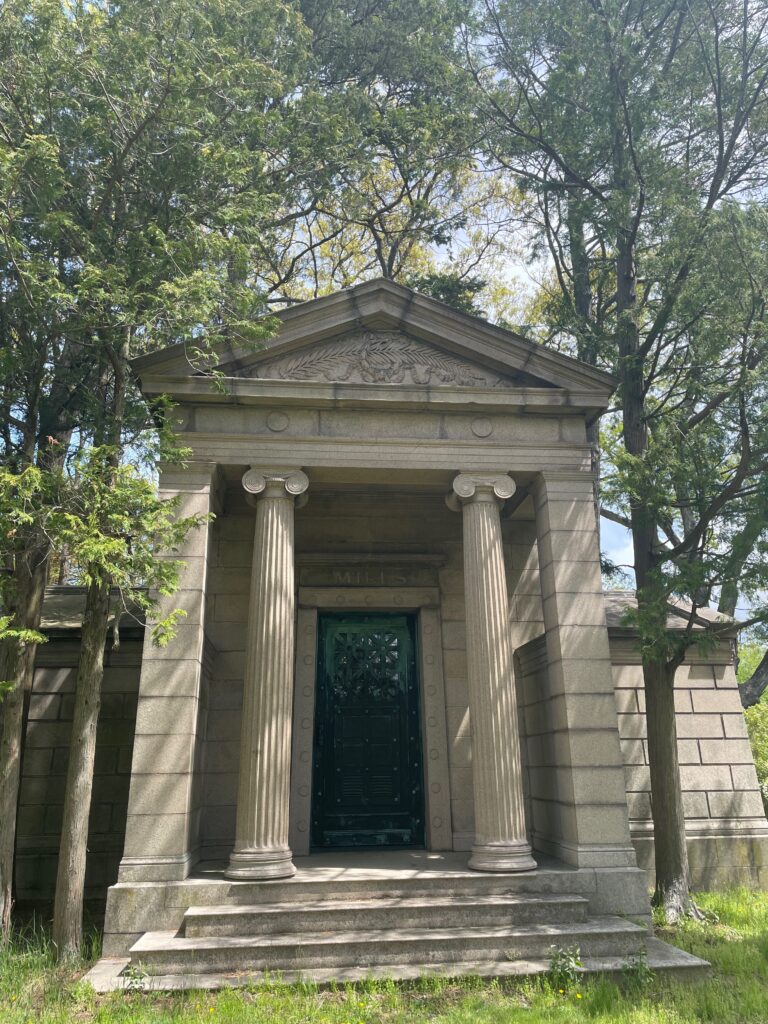Erik Visits an American Grave, Part 1,459
This is the grave of Whitelaw Reid.

Born in 1837 outside of Xenia, Ohio, Reid grew up poor. His family were struggling farmers and they didn’t have much more than the basics of life. But he was determined to get an education and ended up at Miami University. He graduated in 1856 and started writing for newspapers. In the Civil War, he was a war correspondent. He was one of the few correspondents at Shiloh, in the western theater that most of the eastern press had ignored. He was at Gettysburg too. He was among the best journalists of the war and even though he wrote under a pseudonym at first, it didn’t take long for people to find out who this was.
So by the end of war, Reid was a journalist in demand. Horace Greeley hired him in 1868 to work on his New York Tribune. This launched Reid into the stratosphere and he never looked back, not to his poor background, that’s for sure. Reid took over the paper after Greeley’s death in the aftermath of his disastrous 1872 run against Grant, which Reid had supported. Although Reid was disaffected from Grant, he reoriented the Tribune back to what it had been before 1872–a staunch Republican paper. This was now the Gilded Age and while Reid’s Liberal Republicanism that had led him to Greeley in the first place was more or less anti-corrupt, it also was about forgetting about Black Americans. Instead, it was pro-corporate hackery and the Tribune under Reid would become the mouthpiece of Republican elites, of which he himself soon became. In 1881, Reid married Elisabeth Mills, the daughter of the extremely wealthy banker Darius Ogden Mills. They became a couple of the Gilded Age elite, known for their epic parties. And of course there was endless money, giant houses, furnishings from Europe, all that stuff. I’ve been in Mills Mansion in New York, one of the homes of Reid’s new brother-in-law and his wife and it is the typical extremely expensive tastelessness of the Gilded Age. I assume Reid’s homes were similar.
Anyway, as the chief Republican mouthpiece during the Gilded Age, the mediocre to worse presidents of the era wanted to pay him back through the patronage system. Both Hayes and Garfield offered him high ranking diplomatic posts in Germany, but at the time he didn’t think that was appropriate. He also wasn’t married yet so he didn’t have some sweet years in Europe for his wife to think about. That changed when Harrison offered the position of Ambassador to France. That he and his wife was interested in. He was there from 1889 to 1892. Then Harrison decided he needed a new VP candidate. He dumped Levi Morton and offered the VP slot to Reid. He definitely accepted that! Of course the Tribune was just a Republican propaganda rag during this election but it’s not as if that was any different with Reid on or off the ticket. In any case, Harrison lost to Grover Cleveland.
During the Cleveland years, Reid mostly went back to the paper and to just being an extremely rich Republican. But once McKinley took over in 1897, he was back to being an important insider. He was the nation’s special envoy representing the American government at Queen Victoria’s Diamond Jubilee in 1897 and mostly stayed in England for the next few years, unofficially representing American interests with the British government. He and Secretary of State John Hay were best friends anyway; in fact, Reid was the best man at Hay’s wedding. He also was on the peace commission to work out the terms of the Spanish-American War. There is some irony here in that Reid didn’t really support imperialism. But he was a good Republican and was never going to speak out against Republican priorities such as invading Cuba and the Philippines on completely false pretenses. Moreover, Reid had organized pro-American speakers in England during the war to defend the administration’s actions. Partly in response to this, in 1905, Theodore Roosevelt named Reid Ambassador to Britain to cap his career. He retained this position through the Taft administration, until his death in 1912, at the age of 75. He died in London.
Whitelaw Reid is buried in Sleepy Hollow Cemetery, Sleepy Hollow, New York. This is the mausoleum of Reid’s in-laws, if you were wondering about the name not saying Reid. I suppose this is also the grave of various Mills family members who deserve a discussion in this series, so maybe I will have to let this grave serve multiple posts.
If you would like this series to visit other failed VP candidates, you can donate to cover the required expenses here. This is a great list of completely forgotten minor politicians. Arthur Sewall (who?), VP candidate for William Jennings Bryan in 1896, is in Bath, Maine and Allen Thurman (again, who?), who was Cleveland’s failed VP candidate in 1888, is in Columbus, Ohio. Previous posts in this series are archived here and here. And thanks again for the recent surge in donations to support this series. I cannot overstate my thanks for it.


